Heat therapy can dramatically improve your sleep when you follow these proven strategies. Take a 20-30 minute hot bath at 104-109°F or use a sauna at 176°F about 1-2 hours before bedtime. Let your body cool down naturally for 60-90 minutes after heat exposure. Keep your bedroom cool at 65-68°F and use breathable bedding like cotton or bamboo. Stay hydrated with electrolyte-rich drinks after heat sessions. Combine heat therapy with relaxation techniques like deep breathing for enhanced benefits. Time your workouts at least four hours before bed when using heat therapy. These evidence-based tips only scratch the surface of heat therapy's sleep-promoting power.
Timing Your Heat Sessions Right
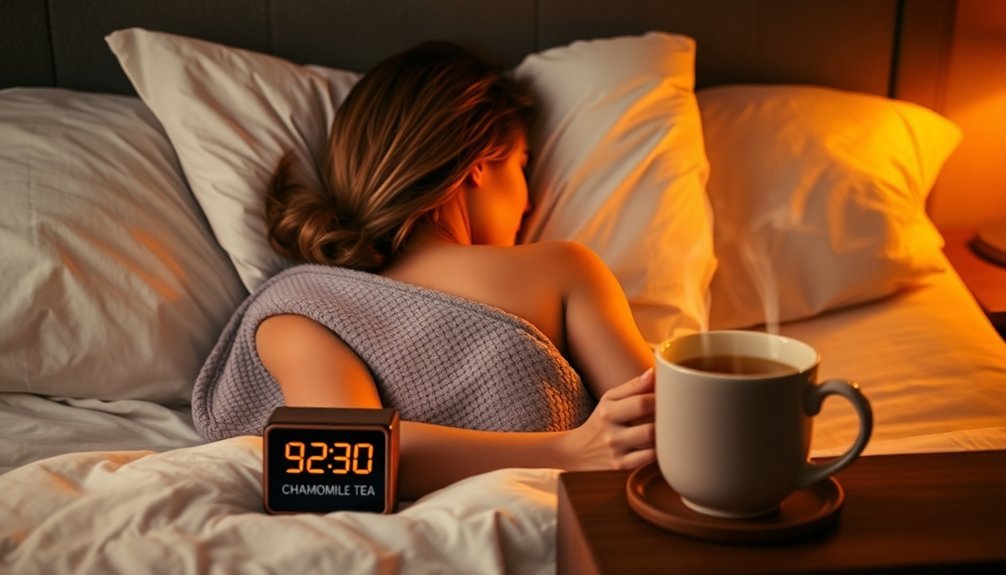
Settling into a regular heat therapy routine comes down to timing. You'll want to schedule your heat sessions 1-2 hours before bedtime, giving your body the essential cool-down period it needs for optimal sleep.
Early evening sessions work best, as they align with your body's natural temperature regulation cycle. The preoptic hypothalamus neurons help regulate both temperature and sleep patterns during this crucial period.
Whether you're using a sauna at 176°F or soaking in a hot bath at 104.9°F, stick to 20-30 minute sessions. This duration is long enough to trigger sleep-promoting benefits while allowing sufficient time for your body temperature to decrease before bed.
You'll want to avoid heat exposure immediately before sleep, as your body needs time to cool down properly.
The cooling period after heat therapy is vital because it triggers the release of sleep-regulating cytokines and increases adenosine levels, making you feel sleepy.
Your bedroom environment plays a key role too – keep it cool and well-ventilated to maintain the temperature-dropping benefits from your heat session.
Remember to wear breathable sleepwear and use natural bedding to help regulate your body temperature throughout the night.
Optimal Temperature Control Strategies
When setting up your bedroom's temperature for heat therapy, you'll want to keep the ambient room temperature between 65-68°F while creating focused heat zones for therapeutic benefits.
Your bedroom should maintain this cool baseline temperature, even as you apply targeted warmth to specific areas using heating pads or warm compresses. Sleep cycle disruption can occur if the room temperature rises above 70°F, significantly impacting your REM sleep quality.
Track your comfort levels and sleep quality at different temperature settings to find your ideal balance between ambient coolness and therapeutic heat application.
Bedroom Climate Control Basics
Creating the perfect sleep environment starts with mastering your bedroom's temperature control. You'll want to maintain temperatures between 65°F and 68°F (18.3°C to 20°C), as your body naturally cools down during sleep.
This temperature range promotes better sleep quality and helps you progress through various sleep stages, especially during essential REM periods. Experimenting with different temperature settings can help you discover your personal comfort zone for optimal rest.
Your bedroom's climate control system needs to account for seasonal changes. In winter, you can set your thermostat slightly lower (16°C to 18°C), while summer calls for slightly higher settings (18°C to 20°C).
Remember that proper ventilation plays a key role in maintaining these ideal conditions.
- Set your thermostat to automatically lower temperatures during your sleeping hours
- Use breathable bedding materials that help regulate your body temperature throughout the night
- Install a ceiling fan or portable fan to improve air circulation and maintain consistent temperatures
If you're sharing your bedroom, consider that individual preferences may vary. You'll need to find a compromise that works for everyone while staying within the recommended range.
For those with specific medical conditions or age-related needs, you might need to adjust these temperatures slightly higher or lower.
Heat Zones During Sleep
Beyond basic room temperature control, understanding heat zones during sleep can revolutionize your rest quality. Your body naturally lowers its temperature during sleep, reaching its coolest point 2-3 hours before you wake up.
The best sleeping temperature ranges from 60°F to 65°F, but you'll need to adjust this based on your personal preferences. Active cooling systems like the Eight Sleep Pod 3 can help maintain temperatures between 55° and 110° F.
If you share your bed, you're likely facing temperature conflicts, as over half of couples report different sleep temperature needs. You can address this challenge with dual zone technology, which lets you and your partner control your individual sleep temperatures. These systems offer both heating and cooling options, allowing precise control over each side of the bed.
To perfect your sleep temperature zones, use breathable bedding materials like cotton, linen, or bamboo. Avoid activities that raise your body temperature before bed, such as hot showers or intense exercise.
Consider having pets sleep in their own space, as they can considerably increase bed temperature. If you experience hot flashes or temperature-related sleep issues, a dual zone system can help maintain your ideal sleep environment throughout the night.
Monitor Temperature For Success
For successful sleep temperature control, monitoring your environment with precision can make the difference between restless and restorative nights. You'll want to maintain your bedroom temperature between 65-68°F (18.3-20°C), as this range has proven ideal for quality sleep.
Since your body naturally cools down during sleep, a slightly cooler environment supports this biological process and enhances sleep continuity. The timing of your temperature drop is especially important, as your body reaches its lowest core temperature approximately two hours before you wake up.
Consider your unique physiological factors when fine-tuning your sleep temperature. If you're taking medications or experiencing hot flashes, you might need to adjust your room temperature accordingly. Remember that body composition and illness can affect how you perceive temperature during sleep.
- Set up a digital thermometer in your bedroom to track temperature fluctuations throughout the night
- Monitor your sleep quality at different temperature settings using a sleep diary or tracking app
- Adjust your ventilation system or use fans to maintain consistent temperatures, especially during seasonal changes
Use breathable bedding materials and guarantee proper air circulation in your room. If you're sharing your bed, you'll need to find a temperature compromise that works for both sleepers, considering that individual temperature preferences can vary substantially.
Sauna Benefits For Deep Sleep
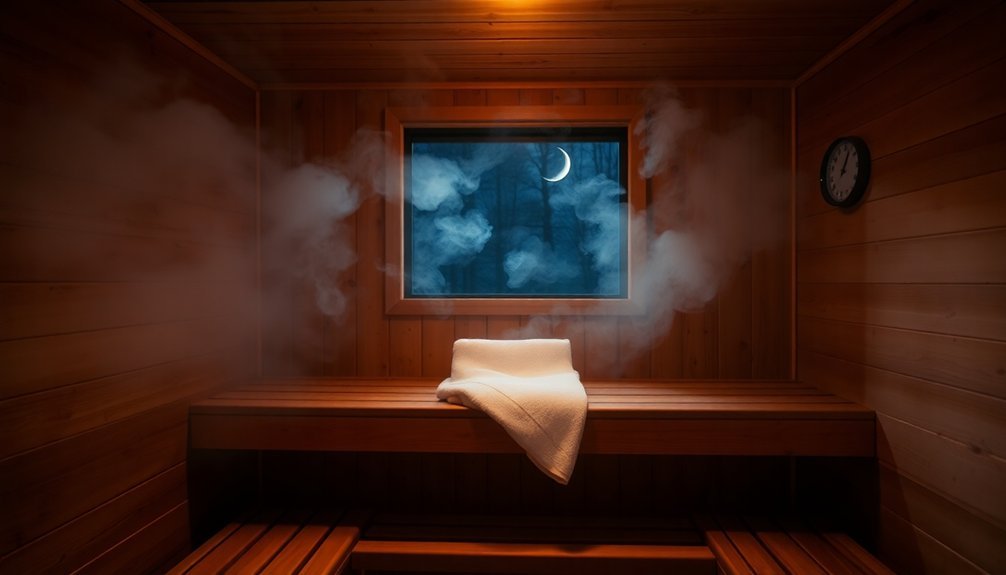
The ancient practice of sauna bathing offers powerful benefits for achieving deeper, more restorative sleep.
When you spend 15-20 minutes in a sauna heated to around 176°F, your body responds with physiological changes that promote better sleep quality. The heat stimulates your system similar to exercise, increasing blood circulation and triggering essential hormone production. Global survey data confirms these benefits, with 83% of users reporting improved sleep.
You'll experience a significant boost in sleep-promoting compounds after your sauna session. As your body cools down, it releases melatonin, growth hormone, and prolactin – all vital for initiating and maintaining deep sleep. These hormonal changes can increase your deep sleep by up to 70% within the first two hours of rest.
To maximize these benefits, schedule your sauna session 1-2 hours before bedtime. This timing allows your body to properly cool down and prepare for sleep.
You'll notice improved sleep continuity, less fragmentation, and enhanced slow-wave sleep – the restorative phase when your body repairs muscles and regulates immune function. Regular sauna use helps regulate your natural sleep-wake cycle, leading to consistent improvements in your sleep quality over time.
Post-Heat Cooldown Protocol
After your heat therapy session, you'll need to follow a careful step-down process that starts with lukewarm exposure and gradually shifts to room temperature.
Your bedroom should be cool and well-ventilated, with temperatures between 65-68°F (18-20°C) to support this cooling shift and promote better sleep. To maximize benefits, apply heat for 15 minutes and wait a minimum of 30 minutes before attempting sleep.
Keep a water bottle nearby, wear loose-fitting clothes, and allow at least an hour of gentle activity before bedtime to let your body temperature naturally regulate.
Gradual Temperature Step Down
When your body prepares for sleep, it naturally begins to cool down about two hours before bedtime, making this phase vital for quality rest. Understanding this natural temperature regulation helps you optimize your sleep environment and timing for better results.
The ideal bedroom temperature ranges between 65-68°F (18.3-20°C), supporting your body's natural thermoregulation during sleep cycles. Studies show that optimal sleep quality occurs between 60-67°F (15.6-19.4°C).
To maximize your gradual temperature step-down, you'll want to work with your body's natural cooling process. If you've engaged in heat therapy or had a hot bath, allow sufficient cooling time before sleep. This gradual decrease mimics your body's natural pattern and helps trigger sleep onset more effectively.
- Time your hot bath or heat therapy session 2-3 hours before bed to allow proper cooling
- Use breathable bedding materials that help regulate your temperature throughout the night
- Keep your bedroom cool and use a fan to circulate air, enhancing the cooling effect
During REM sleep, you're more sensitive to temperature changes, so maintaining consistent cooling is essential. This gradual step-down approach supports deeper sleep cycles and reduces nighttime disruptions, leading to more restorative rest.
Bedroom Environment Optimization
Building on the gradual cooling process, your bedroom environment needs careful calibration to maintain ideal post-heat therapy conditions. Start by setting your thermostat between 60 to 67 degrees Fahrenheit, as this temperature range promotes essential sleep quality after heat therapy.
You'll want to use cooling aids like air conditioning or ceiling fans to maintain this consistent temperature throughout the night.
Control light exposure by installing blackout curtains and dimming your lights as bedtime approaches. Turn off electronic devices at least an hour before sleep, or use night mode settings to reduce blue light emission.
Create a quiet sanctuary by positioning your bed away from noisy areas and using white noise machines or earplugs if needed.
Your bedding choices play a vital role in maintaining comfortable post-therapy temperatures. Select breathable materials and consider using cooling mattress pads to prevent overheating. Test different combinations of sheets and blankets to find what works best for your body's cooling needs.
Remember to keep your bedroom dedicated to sleep and intimacy only, as this helps maintain the peaceful atmosphere you've created through these environmental adjustments.
Post-Sauna Recovery Essentials
Proper recovery following heat therapy demands a systematic cooldown approach to maximize sleep benefits. After your sauna session, let your body temperature drop gradually while focusing on adequate hydration.
You'll want to sip water slowly rather than gulping it down, and consider incorporating electrolyte-rich beverages like coconut water or herbal teas to replenish lost minerals.
Your post-sauna nutrition plays a vital role in enhancing sleep benefits. Choose water-rich fruits like watermelon and oranges, paired with protein-rich options such as Greek yogurt or lean meats. These combinations help restore your body's balance while promoting muscle recovery and relaxation.
For the best results, follow these essential recovery steps:
- Cool down for 15-20 minutes in a room-temperature environment while practicing deep breathing exercises
- Consume a balanced mix of hydrating foods and electrolytes within 30 minutes after your session
- Prepare a light snack combining protein and carbs, such as yogurt with berries or almonds with fruit
Remember to remove all jewelry before your session and maintain proper session lengths of 15-20 minutes to guarantee you're getting the most from your heat therapy routine.
Breathable Bedding Selection
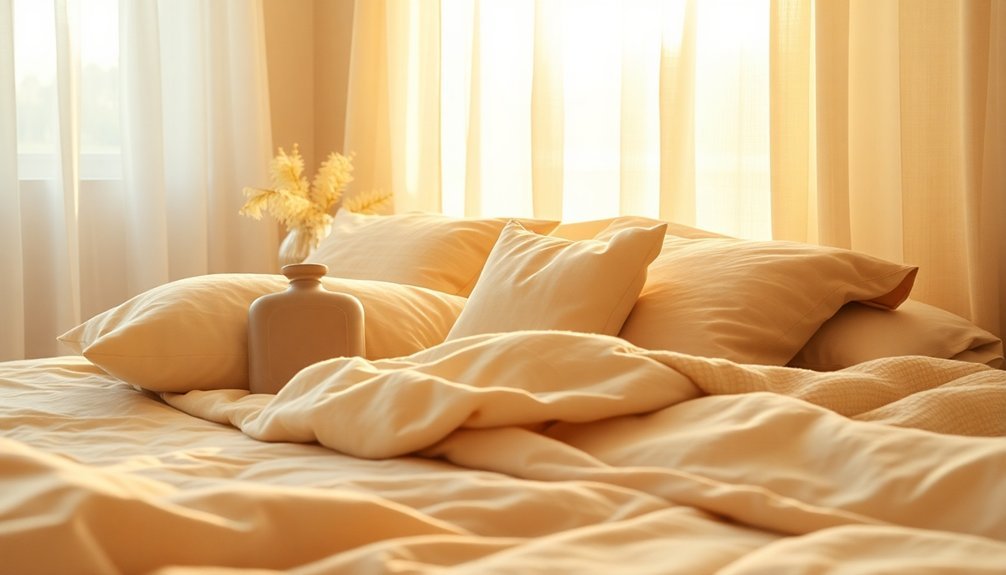
Selecting breathable bedding plays a vital role in managing your sleep temperature and overall comfort. After heat therapy practices like sauna sessions, you'll want to guarantee your bed's environment supports ideal temperature regulation throughout the night.
Choose materials that naturally wick moisture and promote airflow. Cotton remains a reliable choice for its softness and breathability, while linen offers superior moisture-wicking properties.
If you're environmentally conscious, consider bamboo or Tencel bedding, which provide excellent breathability while being sustainable options.
When shopping for breathable bedding, look specifically for labels indicating "cooling" or "breathable" properties. You'll want to pay attention to thread count, but don't assume higher is always better – a moderate thread count often allows for better air circulation.
If you tend to sleep hot or experience night sweats, polyester bedding with moisture-wicking technology might be your best option.
Remember that breathable bedding isn't just about comfort – it's also about health. These materials help reduce allergens and bacteria growth while maintaining a consistent sleep temperature.
Environment Temperature Management
Managing your bedroom's temperature is one of the most critical factors for quality sleep, especially after heat therapy. While your body naturally cools down during sleep, maintaining an ideal temperature between 65°F and 68°F (18.3°C to 20°C) helps guarantee you'll get the most restorative rest.
You'll need to adjust these temperatures seasonally, keeping your room slightly warmer in winter and cooler in summer.
Temperature management isn't just about comfort – it directly impacts your sleep quality and REM cycles. When your bedroom's too hot, you'll experience restlessness and potential insomnia.
Conversely, if it's too cold, you might face disrupted sleep patterns and blood pressure issues. Remember that the temperature under your bedcovers should stay between 27°C to 31°C for the best sleep.
- Monitor your room's temperature using a reliable thermometer, adjusting your heating or cooling system accordingly
- Set your thermostat to 60°F-65°F before bed, allowing your body to naturally regulate its temperature throughout the night
- Consider using programmable climate controls to automatically adjust temperatures based on your sleep schedule and seasonal needs
Pre-Sleep Heat Therapy Routine
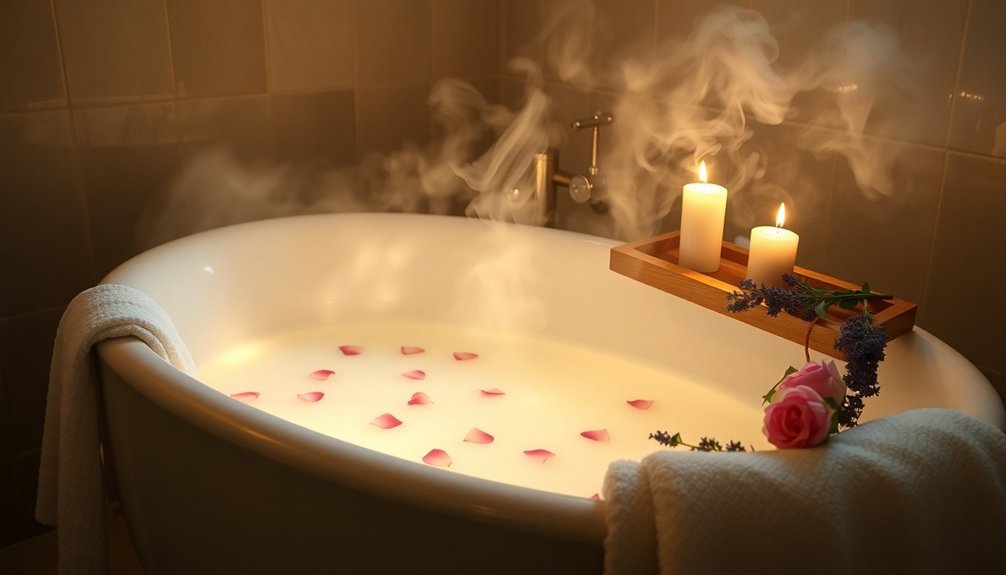
A well-designed pre-sleep heat therapy routine can dramatically improve your sleep quality through strategic temperature exposure. To maximize benefits, you'll want to start your heat therapy 1-2 hours before bedtime, allowing your body enough time to cool down naturally before sleep.
Choose either a hot bath at 104.9°F for 20-30 minutes or a sauna session at 176°F for 15-20 minutes. This exposure activates sleep-inducing cytokines and promotes muscle relaxation, setting you up for deeper sleep cycles.
| Heat Therapy Type | Protocol Details |
|---|---|
| Hot Bath | 104.9°F for 20-30 mins |
| Sauna | 176°F for 15-20 mins |
| Cool Down | 60-90 mins post-therapy |
| Room Temp | Set to 65°F for sleep |
| Frequency | Up to 3x daily |
After your heat therapy, let your body temperature gradually decrease in a cool environment. This cooling process signals your brain it's time to sleep. Don't rush this phase – it's vital for activating your sleep mechanisms. For best results, maintain consistency with your routine and avoid extreme temperature changes right before bed. You'll notice improved sleep quality, enhanced growth hormone secretion, and better muscle recovery over time.
Melatonin Enhancement Through Heat
Your body's heat stress response can naturally boost melatonin production, making strategic heat therapy an effective tool for enhancing sleep-promoting hormones.
You'll want to time your heat exposure about 90 minutes before bed, allowing your body temperature to drop naturally as you approach sleep time, which signals your brain to increase melatonin release.
When you combine this temperature-dropping strategy with good sleep hygiene practices like avoiding blue light and maintaining regular sleep schedules, you're creating ideal conditions for your circadian rhythm to regulate melatonin production effectively.
Heat Triggers Natural Production
Natural thermoregulation plays a vital role in promoting healthy sleep cycles through heat-induced melatonin production. When you expose your body to heat, whether through traditional or infrared saunas, you'll trigger a fascinating biological response that enhances your sleep quality.
As your body temperature rises and then gradually cools down, your pineal gland increases melatonin synthesis, helping regulate your circadian rhythms.
Your hypothalamus's suprachiasmatic nucleus responds to these temperature changes by modulating your body's thermoregulatory set-point. This process directly influences your sleep-wake cycle, making you feel naturally drowsy as your body temperature drops after heat exposure.
- Your skin temperature increases during heat therapy, promoting peripheral heat loss that's strongly associated with sleep onset
- The cooling process after heat exposure signals your body to produce more melatonin, your natural sleep hormone
- Regular heat therapy sessions can establish a consistent pattern of melatonin production, leading to improved sleep quality over time
You'll get the best results by incorporating heat therapy into your pre-bedtime routine, allowing enough time for your body to cool down naturally before sleep.
Timing Your Temperature Drop
In accordance with your body's natural rhythm, timing heat therapy sessions requires strategic planning to maximize melatonin production. Your core temperature naturally begins to drop about two hours before bedtime, which triggers melatonin release and promotes sleepiness.
To work with this process, you'll want to complete your heat therapy session approximately 2-3 hours before you plan to sleep.
When you expose yourself to heat and then allow your body to cool down, you're amplifying the natural temperature decline that signals your brain to produce melatonin. Your body temperature reaches its lowest point around 4 a.m., so you don't want to interfere with this pattern by applying heat too close to bedtime. Instead, time your heat therapy to coincide with your body's pre-sleep cooling process.
Remember that your bedroom temperature should remain between 60-65 degrees Fahrenheit to maintain ideal sleep conditions. After your heat therapy session, you'll want to guarantee your environment supports this natural cooling process.
This temperature range helps sustain the increased melatonin levels and prevents disruptions to your sleep cycle by maintaining the proper thermoregulatory balance throughout the night.
Optimizing Circadian Rhythm Balance
Understanding how heat therapy affects your circadian rhythm creates opportunities to enhance melatonin production naturally. Your body's internal clock responds to environmental cues, particularly temperature changes, which can profoundly impact your sleep-wake cycle.
When you time heat therapy correctly, you're supporting your body's natural tendency to cool down before sleep, which triggers melatonin release and promotes deeper rest.
To effectively balance your circadian rhythm using heat therapy, you'll need to work with your body's natural temperature regulation system. Heat exposure followed by cooling creates a more pronounced temperature drop, signaling your brain that it's time to sleep. However, it's essential to avoid heat therapy too close to bedtime, as this can disrupt your natural temperature regulation.
- Apply heat therapy 2-3 hours before bedtime to allow proper cooling time
- Keep your bedroom temperature between 60-67°F (15-19°C) to support natural melatonin production
- Combine heat therapy with reduced light exposure in the evening to maximize melatonin synthesis
Remember that consistent timing of your heat therapy sessions helps reinforce your circadian rhythm, leading to more predictable and restorative sleep patterns.
Combining Movement With Heat
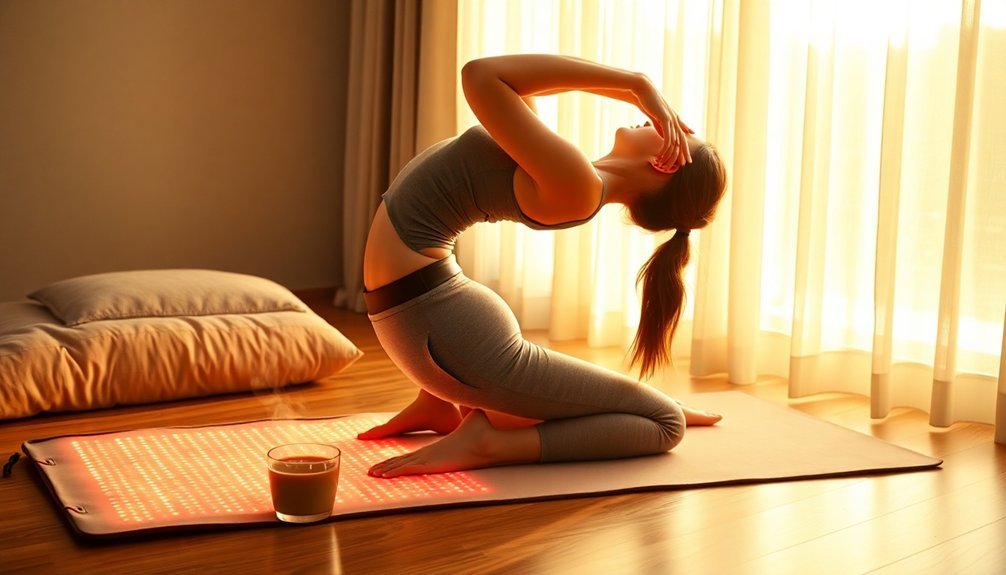
Combining movement with heat therapy creates a powerful synergy for enhancing sleep quality. When you exercise, your body increases its energy demand, releasing ATP and adenosine signals that naturally promote sleepiness.
Adding heat therapy to your movement routine amplifies these benefits by boosting growth hormone levels and increasing sleep-promoting hormones like prolactin.
You'll get the best results by timing your heat and exercise combination strategically. Complete your workout at least four hours before bedtime, and consider using an infrared sauna or hot bath afterward. A 20-minute sauna session at 176°F can trigger the release of somnogenic cytokines that enhance non-rapid eye movement sleep.
For muscle recovery and relaxation, try alternating between heat and cold therapy after exercise. You can use heating pads, moist heat packs, or warm baths before bedtime to maintain the benefits. Just remember to allow your body temperature to cool down before sleep.
If you're dealing with restless legs syndrome or sleep difficulties, this non-pharmaceutical approach can be particularly effective when practiced consistently as part of your daily routine.
Heat Duration For Sleep Success
Sleep success hinges on precise heat therapy timing, with research showing that 15-20 minutes of heat exposure provides ideal benefits. You'll want to schedule your heat therapy session 1-2 hours before bedtime, allowing your body temperature to naturally drop and signal sleep readiness.
Most people find the best results with a 20-minute session in a 176°F (80°C) sauna, though you should adjust this based on your personal comfort and tolerance.
To maximize your heat therapy's effectiveness, pay attention to these critical timing factors:
- Keep your sessions between 15-20 minutes – longer isn't better and can interfere with your body's natural cooling process
- Schedule your heat exposure at least 1-2 hours before bed to allow for proper cool-down time
- Monitor your response and adjust duration if you're sensitive to heat or have specific health considerations
Remember to take into account your individual needs when determining session length. If you're new to heat therapy or have health concerns, start with shorter durations and gradually increase as comfortable. You'll also want to factor in environmental temperatures and adjust accordingly to prevent overheating, which can disrupt your sleep quality.
Frequently Asked Questions
Can Heat Therapy Help With Chronic Insomnia Caused by Anxiety?
While heat therapy can be soothing, it's not the most effective treatment for anxiety-related insomnia. You'll get better results from cognitive behavioral therapy and relaxation techniques that directly address your anxiety patterns.
Is Heat Therapy Safe During Pregnancy for Improving Sleep?
You can safely use heat therapy during pregnancy to improve sleep, but you'll need to follow specific guidelines: keep temperatures below 100°F, limit exposure time, and avoid hot baths during early pregnancy stages.
How Does Altitude Affect the Effectiveness of Heat Therapy for Sleep?
You'll find limited research on altitude's direct impact on heat therapy for sleep. At higher altitudes, you should be extra cautious with heat therapy since both altitude and heat can independently disrupt sleep patterns.
Can Heat Therapy Interfere With Sleep Medications or Supplements?
Yes, heat therapy can interfere with your sleep medications and supplements. If you're taking antidepressants, antipsychotics, or sedatives, you'll need to be extra careful as these can affect your body's temperature regulation.
Should Diabetics Modify Their Heat Therapy Approach for Better Sleep Results?
Yes, you'll need to modify heat therapy if you're diabetic. Use layers between heating sources and skin, avoid direct heat contact, and regularly check for redness. Consider safer alternatives like diabetic socks or fleece blankets.
In Summary
Remember, you'll get the most from heat therapy by making it a consistent part of your sleep routine. Listen to your body's response and adjust temperatures and timing accordingly. You're now equipped with powerful tools to harness heat's sleep-enhancing benefits. Whether you choose a warm bath, sauna session, or heating pad, you'll find these techniques can transform your sleep quality when practiced mindfully.

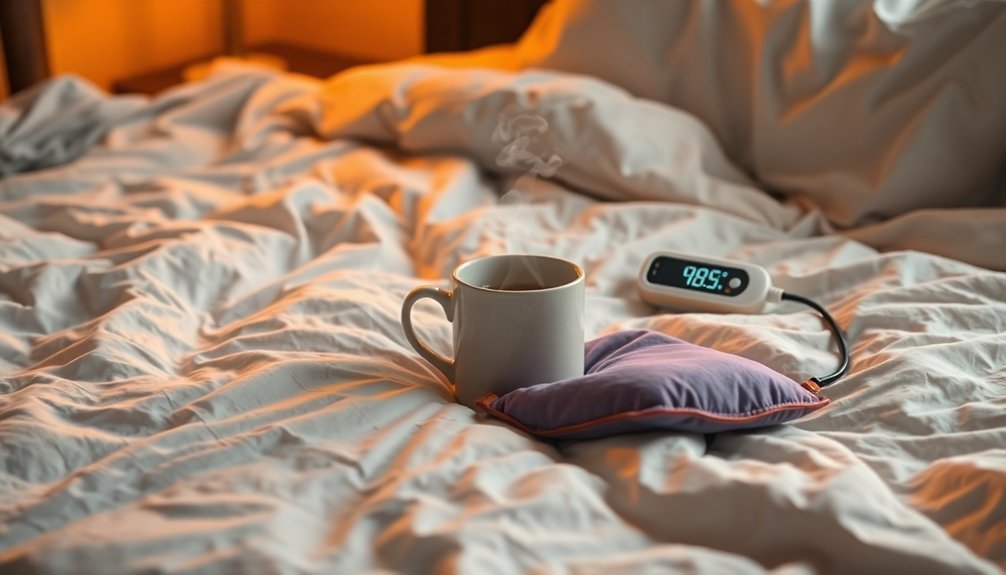



Leave a Reply